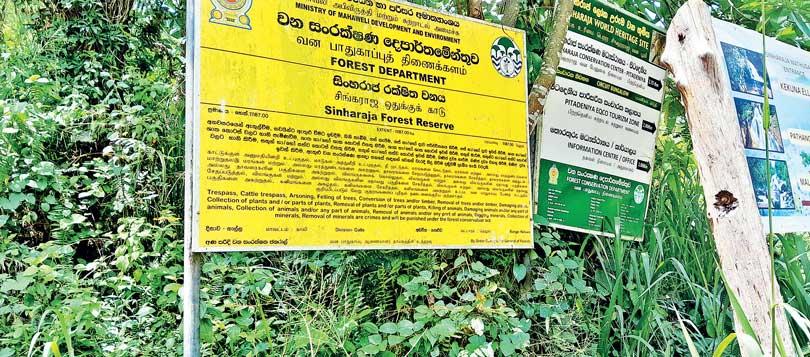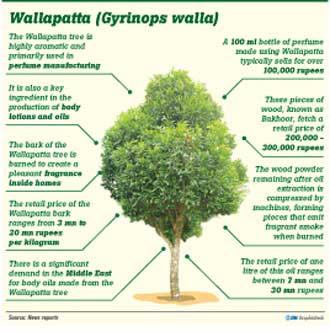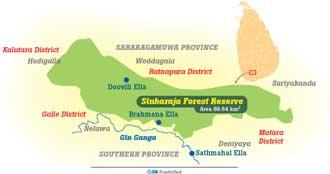07 May 2024 - {{hitsCtrl.values.hits}}

The billboard indicating the presence of Sinharaja Forest Reserve and rules specified for visitors laid out by the Conservator General of Forests
 The Sinharaja Forest reserve, located in the southwest of the Central Highlands of Sri Lanka, spans over 11,250 hectares. Bordering the Galle, Matara, and Ratnapura districts, the Sinharaja Forest has attracted global attention and has been designated as a Biosphere Reserve and World Heritage Site by UNESCO.
The Sinharaja Forest reserve, located in the southwest of the Central Highlands of Sri Lanka, spans over 11,250 hectares. Bordering the Galle, Matara, and Ratnapura districts, the Sinharaja Forest has attracted global attention and has been designated as a Biosphere Reserve and World Heritage Site by UNESCO.
Being a portion of the Lowland Rainforest Eco-zone, this hilly virgin rainforest has been naturally shielded from commercialization due to people finding accessibility to the area being a challenge. Another contributing factor to its preservation is its designation as a Biosphere Reserve in 1978 and as a World Heritage Site in 1988. are fed by the streams flowing from the forest; giving rise to several picturesque waterfalls such as Doovili Ella, Brahmana Ella and Ura Wetunu Ella. In the Sinharaja Forest, one can observe flora species spread across five main layers. The upper canopy layer has plants such as Batu Naa, Welipiyanna, Keena, Thiniya
|
A growth of Agarwood (seen in black) can be seen |
Dun, Beraliya and Kiri Hambiliya. The mid-canopy layer comprises plants like Hedewaka, Malaboda, Diya Na and Katamodha. Madol and Athuketiya are found in the understory layer. The forest floor consists of species like Wal Bombu, Pinibaru and Perathambala. Climbing plants and stemless plants form distinct layers, including wild pepper and ferns. Many of the plants in this forest are endemic to Sri Lanka. Notably, among plants showcasing significant diversity, those found in Mulawella, Hinipitigala and the Morningside area exhibit traits commonly found in mountainous forests. Researchers claim that Sinharaja, with over 75 percent endemic plant species, shelters hundreds of plants yet to be discovered by the world.
Significant demand in the Middle East
Sinharaja has 13 out of the 25 plant groups endemic to Sri Lanka. Approximately 60 percent of plant species with a trunk circumference less than 30 cm are native to Sri Lanka. Within the forest, there are 340 species of plants with timber value, with 192 being exclusive to Sri Lanka. Among these, 15 species are only found within Sinharaja.
Despite its unique characteristics, the Sinharaja forest is now under threat of destruction due to the illegal activity of cutting down of Wallapatta (Gyrinops walla) trees, located within its boundaries. The racket involving the felling of Wallapatta in Sinharaja has been ongoing for a long time. During Daily Mirror’s visit to the area, it was noticeable that these activities are being carried out openly in public.
The motive behind this illegal activity is to cut down Wallapatta trees and extract agarwood from them. Residents of Deniyaya maintain that more than 200,000 Wallapatta plants in Sinharaja have been illegally cut during the past five years. The Wallapatta tree is highly aromatic and primarily used in perfume manufacturing. It is also a key ingredient in the production of body lotions and oils. Moreover, the bark of the Wallapatta tree is burned to create a pleasant fragrance inside homes. The retail price of the Wallapatta bark ranges from 3 million to 20 million rupees per kilogram.
There is a significant demand in the Middle East for body oils made from the Wallapatta tree. The retail price of one litre of this oil ranges between 7 million and 30 million rupees. The wood powder remaining after oil extraction is compressed by machines, forming pieces that emit fragrant smoke when burned. These pieces of wood, known as Bakhoor, fetch a retail price of 200,000-300,000 rupees. A 100 ml bottle of perfume made using Wallapatta typically sells for over 100,000 rupees.
Not every Wallapatta tree produces aromatic agarwood. Out of 100 trees, agarwood forms in only 4 or 5. We cannot determine if a Wallapatta tree contains agarwood just by observing it from the outside. The presence of Agarwood can only be confirmed by cutting into the tree.
Agarwood occurs naturally in the Wallapatta tree. Microorganisms enter the tree through broken branches and insect burrows. When combined with water and air, Agarwood forms within the Wallapatta plant as a reaction. Thin pieces of wood are used for oil extraction, while heavier parts are sold as wood chips.
 Residents of Deniyaya alleged that a prominent Sri Lankan sportstar is involved in this illicit activity. According to them, he is working on generating a significant income by continuously harvesting Agarwood from Wallapatta trees in Sinharaja through these relentless tree cutting activities. Sri Lanka’s Wallapatta oil is in high demand globally; leading to an increase in its exportation. During this newspaper’s visit to the area, our team was able to discover that there are around 18 undisclosed sites in the vicinity of Deniyaya where oil from Wallapatta is extracted from.
Residents of Deniyaya alleged that a prominent Sri Lankan sportstar is involved in this illicit activity. According to them, he is working on generating a significant income by continuously harvesting Agarwood from Wallapatta trees in Sinharaja through these relentless tree cutting activities. Sri Lanka’s Wallapatta oil is in high demand globally; leading to an increase in its exportation. During this newspaper’s visit to the area, our team was able to discover that there are around 18 undisclosed sites in the vicinity of Deniyaya where oil from Wallapatta is extracted from.
The oil obtained from those oil-extracting sites finally reaches this sportstar. According to residents, that oil is sent to Ayagama. There is a good price for Wallapatta bark and parts of the wood which is used for oil extraction in Ayagama.
A kilo of bark costs about 300 rupees. Additionally, we were informed by a person- who is referred to by the nickname Wallapatta Sudda in Deniyaya- that the woodchips sold for 100 rupees in Deniyaya can be sold for 300 rupees in Ayagama.
This newspaper contacted Wallapatta Sudda through an informant and found out that he obtains 7.5 kilograms of Wallapatta per week. We encountered difficulties in determining how many trees should be cut to produce 7.5 kilograms of Wallapatta per week. Wallapatta Sudda informed our source that there are plenty of Wallapatta trees in the forest, and he can cut down any amount.
The law related to Wallapatta trees
Some individuals engage in the illegal export of Wallapatta oil. For the record ‘activities such as cutting down, transporting, selling and attempting to sell Wallapatta trees have been declared as illegal activities by the Forest Conservation Ordinance in clause 24 of the Gazette notification number 68/14 issued on 1979-12-26 under the Law specified by number 1 of 1979. Those who refrain from such activities often transfer their supplies to Ayagama through brokers. Those who are not engaged in oil extraction provide the Wallapatta bark to Ayagama via second or third parties. Eventually, all these products head toward the sportstar. Wallapatta Sudda mentioned that they would continue to supply Wallapatta to the sportstar due to the generous payment he makes to suppliers. It was revealed by Wallapatta Sudda that there are boilers used to extract Wallapatta oil in Ayagama and that there is a weekly requirement of 750 kilos of Wallapatta to meet this purpose.
Oil extraction done illegally
“We extract oil discreetly using small oil extraction units. The process is quite simple; similar to the method used in the production of illegal alcohol. Dried and crushed pieces of Wallapatta bark are placed in barrels, typically around 30-40 kg of dry wood at a time and is heated after water is added. Subsequently, the oil seeps out gradually, stopping after about four days. Only a small amount of oil can be obtained. From 30-40 kg of wood powder, one can obtain about 10 ml of oil. Agarwood trees yield between 1-2 kilos of dry wood, with larger trees providing up to 2 kilos. It takes a minimum of 2000 trees to produce one litre of oil,” shared a Wallapatta oil extractor who requested anonymity.
“There are instances where the police stops us while transporting wood to Ayagama for oil production. When questioned about our destination, we simply say ‘Ayagama,’ and they do not inquire further. Following that, the operation is simple,” said a supplier of Wallapatta to Ayagama.
“Once, the police anti-corruption unit invaded a Wallapatta oil extraction site and found the oil. We had about 1000 kilos of wood chips ready for oil extraction. When they asked for what the wood chips were for, we mentioned the name of the sportstar. That news generated interest in television broadcasting of these activities, but nothing came of it. This person is trying to exploit Sinharaja and make a fortune,” said the Wallapatta supplier from Ayagama.
“We are out in the forests for weeks and months, cutting down Wallapatta trees. If we ever get arrested by the forest officers or the police, it is the sportstar who saves us. This business is operated within a vast network,” he added.
Bodhidasa Rukuge, a resident of Kotapola, Deniyaya, expressed concern, stating, “They are secretly cutting Wallapatta and devastating the Sinharaja Reserve. This is a grave crime. If this continues, the next generation may not even see a Wallapatta tree. When entering the forest, one can see the widespread felling of Wallapatta trees, left to decay. There is an illicit business. It is said that Wallapatta is being supplied to a sportstar. Alongside a group of individuals engaged in cutting Wallapatta, this player is reportedly harvesting in this business inside Sinharaja to extract the Agarwood component. We urge the authorities to intervene and halt this destruction,” Rukuge said.
When questioned about this, Deniyaya Police OIC, Chief Inspector (CI) Chandana Amararathna stated that there are no trees suitable for harvesting Wallapatta in the Sinharaja forest. “The trees found scattered in the area are now being cut down. These are not transported over long distances; instead, they are sold by the gram to collectors of Wallapatta, including both
|
Sinharaja Forest Reserve |
black chips and other chips. Recently, no black chips have been discovered. Typically, six to seven are found a year. In 2024 alone, there have been four cases of Wallapatta transportation, with the exact locations undisclosed. The individuals were arrested while carrying pieces weighing between 250 to 300 grams. Legal action has been taken against them in accordance with the forest conservation report,” said CI Amararathna.
Commenting on this, Chief Incumbent of Pothdeniya Ashokarama temple, Ven Sumana, emphasised, “The authorities should prioritise halting the large-scale destruction of Wallapatta trees at the World Heritage Sinharaja site. According to the information we receive, a popular sportstar of this country is allegedly behind the cutting of Wallapatta trees and exploiting the local community for this purpose. Despite residents informing the police and the divisional secretary, we have come to know that this destruction is taking place with their awareness. As a result, people are now hesitant to report incidents of Wallapatta cutting to the authorities. Even when complaints are lodged, the law is not properly enforced,” the priest said.
We also sought clarification on this matter from Deniyaya Kotapola Divisional Secretary, W.P. Shanika I. Perera. She said, “Until you brought it to my attention just now, there have been no reports of illegal cutting down of Wallapatta trees in Sinharaja. Neither has the Grama Niladhari officer received any complaints. Moreover, Sinharaja has a forest conservation office, and I have not received any complaints, even informally. However, I will investigate this matter further,” said Perera.
This newspaper then contacted Vimesha Weerasinghe, the Forest Range Officer of the Deniyaya Office of the Department of Forest Conservation, regarding the cutting down of
|
A person is seen cutting a Wallapatta tree |
Wallapatta trees in Millawa Reserve, Morawaka, in the Sinharaja Reserve in Beveraliya, Deniyaya. He responded, “We routinely conduct joint raids to safeguard the Deniyaya Forest Range, including Sinharaja and other reserves. Through the joint raids, we have apprehended individuals involved in Wallapatta felling and have enforced the law. Cases have been brought before Moravaka and Deyyandara courts. I am unaware of any allegations suggesting that we are neglecting forest protection. However, should a suspicious individual enter Sinharaja or any other reserve, we have an information network in place to promptly report it. Using this information, we take swift action and take the necessary decisions,” said Weerasinghe.


22 Dec 2024 4 hours ago
22 Dec 2024 5 hours ago
22 Dec 2024 6 hours ago
22 Dec 2024 8 hours ago
22 Dec 2024 8 hours ago